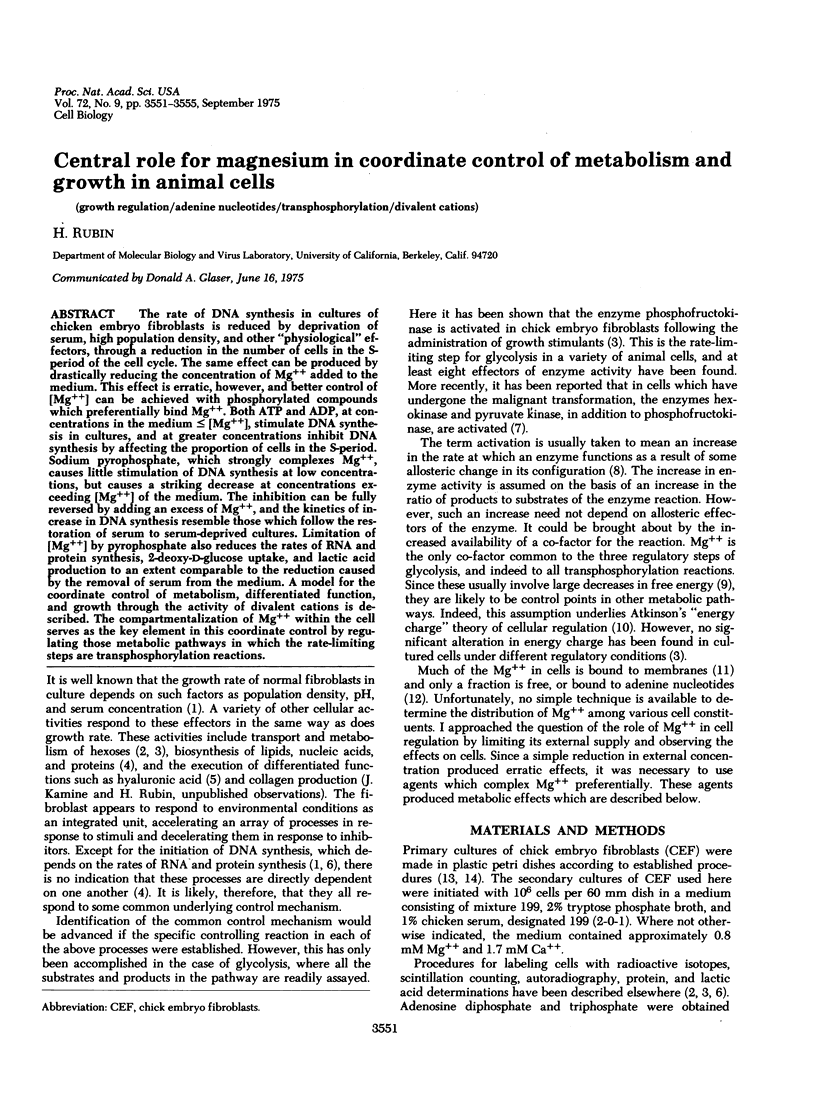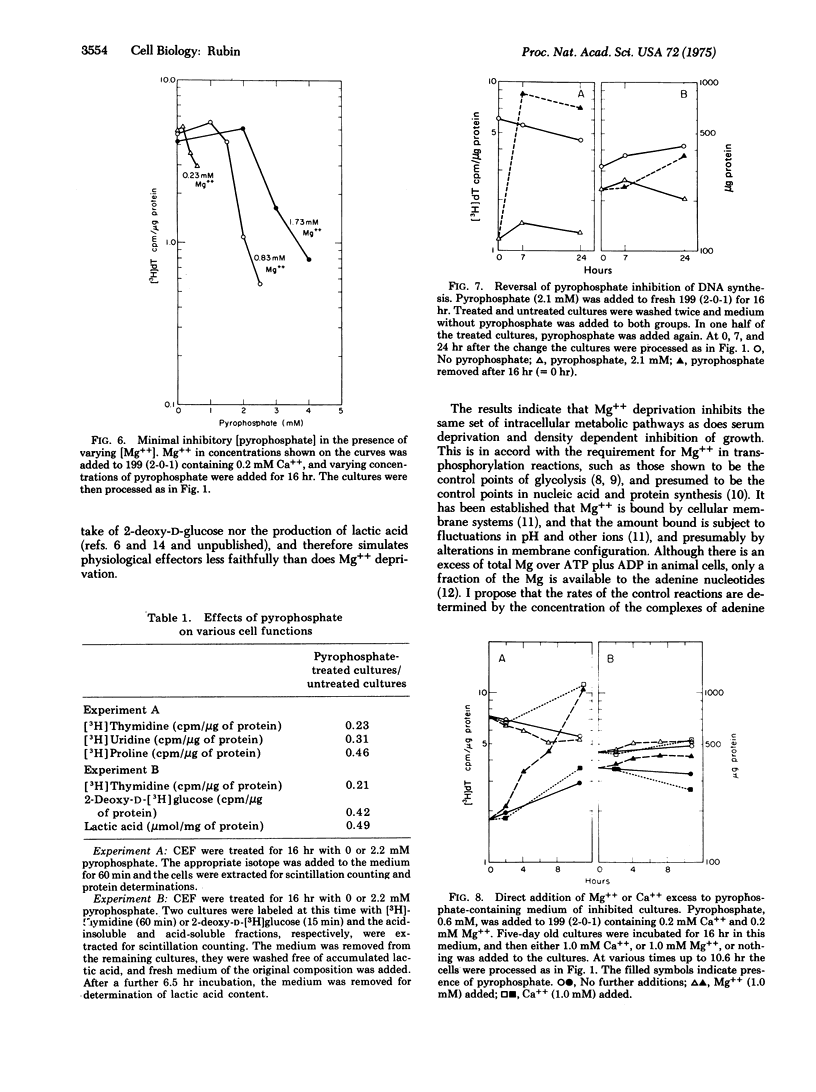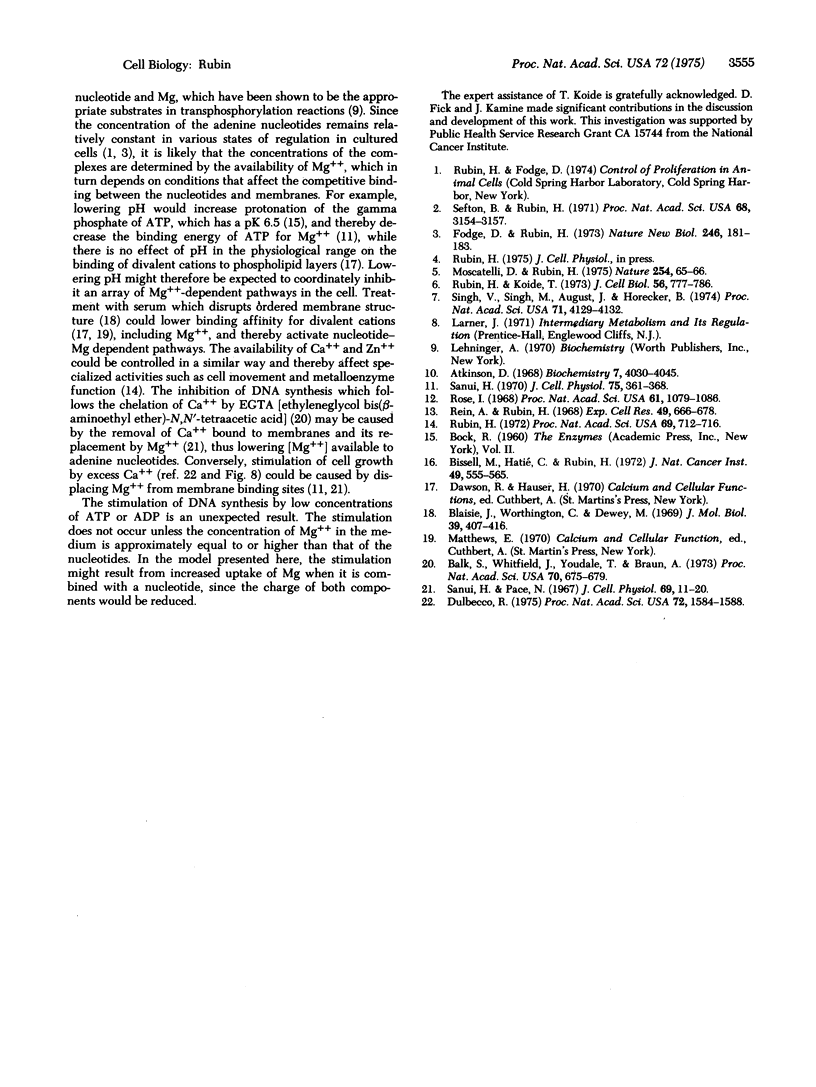Abstract
The rate of DNA synthesis in cultures of chicken embryo fibroblasts is reduced by deprivation of serum, high population density, and other "physiological" effectors, through a reduction in the number of cells in the S-period of the cell cycle. The same effect can be produced by drastically reducing the concentration of Mg++ added to the medium. This effect is erratic, however, and better control of [Mg++] can be achieved with phosphorylated compounds which preferentially bind Mg++. Both ATP and ADP, at concentrations in the medium less than or equal to [Mg++], stimulate DNA synthesis in cultures, and at greater concentrations inhibit DNA synthesis by affe-ting the proportion of cells in the S-period. Sodium pyrophosphate, which strongly complexes Mg++, causes little stimulation of DNA synthesis at low concentrations, but causes a striking decrease at concentrations exceeding [Mg++] of the medium. The inhibition can be fully reversed by adding an excess of Mg++, and the kinetics of increase in DNA synthesis resemble those which follow the restoration of serum to serum-deprived cultures. Limitation of [Mg++] by pyrophosphate also reduces the rates of RNA and protein synthesis, 2-deoxy-D-glucose uptake, and lactic acid production to an extent comparable to the reduction caused by the removal of serum from the medium. A model for the coordinate control of metabolism, differentiated function, and growth through the activity of divalent cations is described. The compartmentalization of Mg++ within the cell serves as the key element in this coordinate control by regulating those metabolic pathways in which the rate-limiting steps are transphosphorylation reactions.
Full text
PDF




Selected References
These references are in PubMed. This may not be the complete list of references from this article.
- Atkinson D. E. The energy charge of the adenylate pool as a regulatory parameter. Interaction with feedback modifiers. Biochemistry. 1968 Nov;7(11):4030–4034. doi: 10.1021/bi00851a033. [DOI] [PubMed] [Google Scholar]
- Balk S. D., Whitfield J. F., Youdale T., Braun A. C. Roles of calcium, serum, plasma, and folic acid in the control of proliferation of normal and Rous sarcoma virus-infected chicken fibroblasts. Proc Natl Acad Sci U S A. 1973 Mar;70(3):675–679. doi: 10.1073/pnas.70.3.675. [DOI] [PMC free article] [PubMed] [Google Scholar]
- Bissell M. J., Hatié C., Rubin H. Patterns of glucose metabolism in normal and virus-transformed chick cells in tissue culture. J Natl Cancer Inst. 1972 Aug;49(2):555–565. [PubMed] [Google Scholar]
- Blasie J. K., Worthington C. R. Molecular localization of frog retinal receptor photopigment by electron microscopy and low-angle X-ray diffraction. J Mol Biol. 1969 Feb 14;39(3):407–416. doi: 10.1016/0022-2836(69)90135-1. [DOI] [PubMed] [Google Scholar]
- Dulbecco R., Elkington J. Induction of growth in resting fibroblastic cell cultures by Ca++. Proc Natl Acad Sci U S A. 1975 Apr;72(4):1584–1588. doi: 10.1073/pnas.72.4.1584. [DOI] [PMC free article] [PubMed] [Google Scholar]
- Fodge D. W., Rubin H. Activation of phosphofructokinase by stimulants of cell multiplication. Nat New Biol. 1973 Dec 12;246(154):181–183. doi: 10.1038/newbio246181a0. [DOI] [PubMed] [Google Scholar]
- Moscatelli D., Rubin H. Increased hyaluronic acid production on stimulation of DNA synthesis in chick embryo fibroblasts. Nature. 1975 Mar 6;254(5495):65–66. doi: 10.1038/254065a0. [DOI] [PubMed] [Google Scholar]
- Rein A., Rubin H. Effects of local cell concentrations upon the growth of chick embryo cells in tissue culture. Exp Cell Res. 1968 Mar;49(3):666–678. doi: 10.1016/0014-4827(68)90213-9. [DOI] [PubMed] [Google Scholar]
- Rose I. A. The state of magnesium in cells as estimated from the adenylate kinase equilibrium. Proc Natl Acad Sci U S A. 1968 Nov;61(3):1079–1086. doi: 10.1073/pnas.61.3.1079. [DOI] [PMC free article] [PubMed] [Google Scholar]
- Rubin H. Inhibition of DNA synthesis in animal cells by ethylene diamine tetraacetate, and its reversal by zinc. Proc Natl Acad Sci U S A. 1972 Mar;69(3):712–716. doi: 10.1073/pnas.69.3.712. [DOI] [PMC free article] [PubMed] [Google Scholar]
- Rubin H., Koide T. Inhibition of DNA synthesis in chick embryo cultures by deprivation of either serum or zinc. J Cell Biol. 1973 Mar;56(3):777–786. doi: 10.1083/jcb.56.3.777. [DOI] [PMC free article] [PubMed] [Google Scholar]
- Sanui H. pH dependence of the effect of adenosine triphosphate and ethylenediaminetetraacetate on sodium and magnesium binding by cellular membrane fragments. J Cell Physiol. 1970 Jun;75(3):361–368. doi: 10.1002/jcp.1040750312. [DOI] [PubMed] [Google Scholar]
- Sefton B. M., Rubin H. Stimulation of glucose transport in cultures of density-inhibited chick embryo cells. Proc Natl Acad Sci U S A. 1971 Dec;68(12):3154–3157. doi: 10.1073/pnas.68.12.3154. [DOI] [PMC free article] [PubMed] [Google Scholar]
- Singh V. N., Singh M., August J. T., Horecker B. L. Alterations in glucose metabolism in chick-embryo cells transformed by Rous sarcoma virus: intracellular levels of glycolytic intermediates. Proc Natl Acad Sci U S A. 1974 Oct;71(10):4129–4132. doi: 10.1073/pnas.71.10.4129. [DOI] [PMC free article] [PubMed] [Google Scholar]


